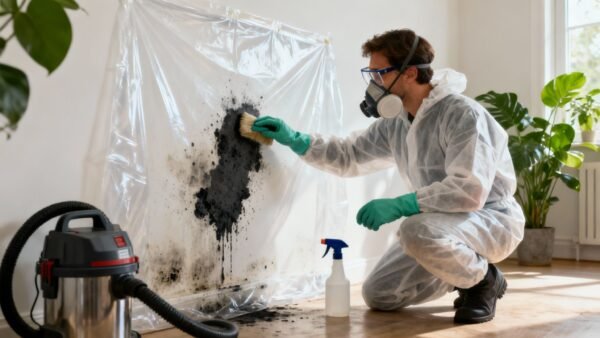
A Homeowner’s Guide to Safe Removal of Mold in Los Angeles
That sinking feeling when you spot mold is universal, especially in the humid pockets of Los Angeles. But before you grab the bleach, take a breath. The first step in
When disaster strikes and your home is suddenly underwater, the first question racing through your mind is almost always: “How much is this going to cost?” The truth is, the water damage cleanup cost can vary wildly, especially in a place like Los Angeles where a burst pipe in the Hollywood Hills can present different challenges than a flooded basement in Sherman Oaks. On average, homeowners find themselves paying anywhere from $1,300 to over $6,000 for professional help.
But that’s just a ballpark figure. The final bill for your water damage cleanup cost really depends on the scale of the disaster—how bad the damage is, what kind of water you’re dealing with, and how much of your home is affected. This guide breaks down every factor so you can make informed decisions.
Ready to get a handle on your situation? Our team offers 24/7 emergency services across Los Angeles County.
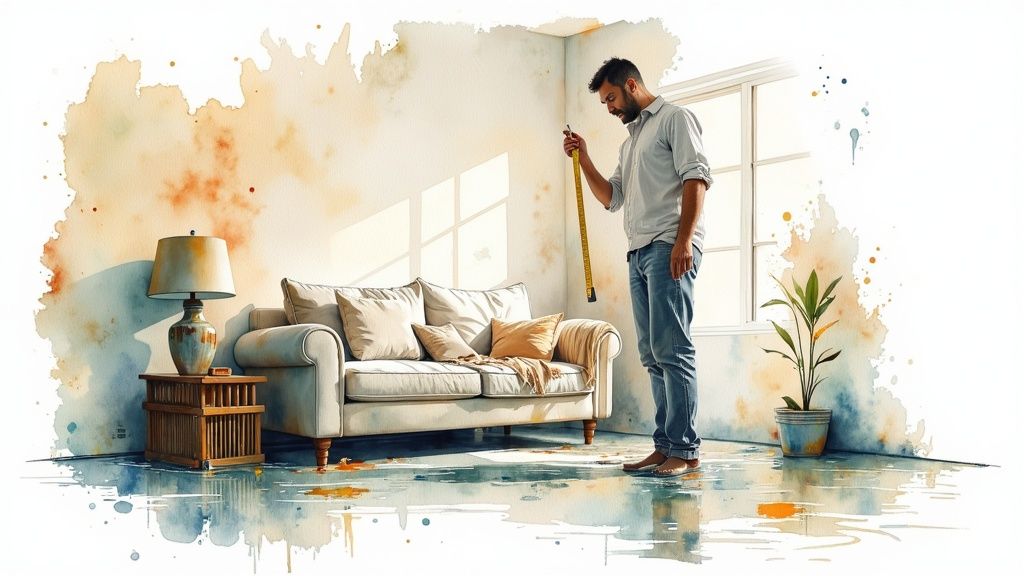
That initial shock of finding a flooded room quickly turns into financial anxiety. Getting a handle on the potential costs upfront helps you make clear-headed decisions when you’re stressed. The total expense isn’t just one flat fee; it’s a combination of crucial services, from emergency water extraction and structural drying to the final repairs that put your home back together.
To give you a clearer picture, restoration costs are often calculated per square foot, with prices ranging from $3.75 to $12 per square foot. A major factor in that price is the type of water involved. “Clean water” from a burst supply line is the least expensive to handle ($3.75–$7 per square foot), while contaminated “black water” from a sewer backup is far more intensive and costly ($7–$12 per square foot).
Think of the total bill as a direct reflection of the incident’s scale. A small overflow from a kitchen sink in a Van Nuys condo is a completely different beast than a burst pipe that soaks multiple rooms in a Beverly Hills home. The longer water sits, the more destructive it becomes, driving up costs for things like mold prevention and structural repairs. If you’re worried about those secondary issues, our mold remediation cost calculator can give you an idea of how quickly hidden problems can impact your budget.
To help you gauge the potential financial scope, here’s a quick breakdown of what you might expect.
| Damage Scale | Common Causes | Estimated Cost Range |
|---|---|---|
| Small Scale | Contained appliance leak, minor toilet overflow, small roof leak | $1,300 – $4,500 |
| Medium Scale | Burst pipe affecting one or two rooms, significant roof leak | $4,500 – $8,000 |
| Large Scale | Major flooding, sewer backup, storm damage affecting multiple levels | $8,000 – $25,000+ |
While this table offers a high-level overview, every situation is unique. The most important takeaway is this: the faster you act, the more control you have over the final water damage cleanup cost. Calling in a professional immediately stops the damage in its tracks, slashes the risk of mold, and ultimately saves you a fortune on more extensive repairs down the road.
Not all water is created equal. When it comes to the water damage cleanup cost, the type of water flooding your home is one of the biggest factors that will drive your final bill. A simple leak from a clean supply line is a world away from a sewer backup, and the cleanup process reflects that.
Restoration pros, guided by the IICRC (Institute of Inspection, Cleaning and Restoration Certification), classify water into three distinct categories based on its contamination level. Each category demands a completely different cleanup strategy, safety protocol, and level of intensity—which all translate directly into cost.
This is the least hazardous type of water damage you can face. Think of it as water coming straight from a sanitary source.
Common sources of Category 1 water include:
But even “clean” water won’t stay that way for long. If left to sit for more than 48 hours, it can degrade into Category 2 as it soaks into building materials and mixes with bacteria. Acting fast is key to keeping costs down.
This is where things get more serious. Grey water contains a significant level of contamination and can cause illness if you come into contact with it. Think of it as water that has been used but doesn’t contain raw sewage.
Analogy: If Category 1 is like spilling a glass of tap water, Category 2 is like the drain water from your dishwasher—it’s full of soaps, food particles, and other contaminants that require much more than just drying.
Common sources of Category 2 water include:
Cleaning up grey water isn’t just about extraction. It involves deep cleaning and sanitizing every affected surface to kill any potential pathogens.
The infographic below shows just how much the water source—along with other key factors—influences the final cost of a project.
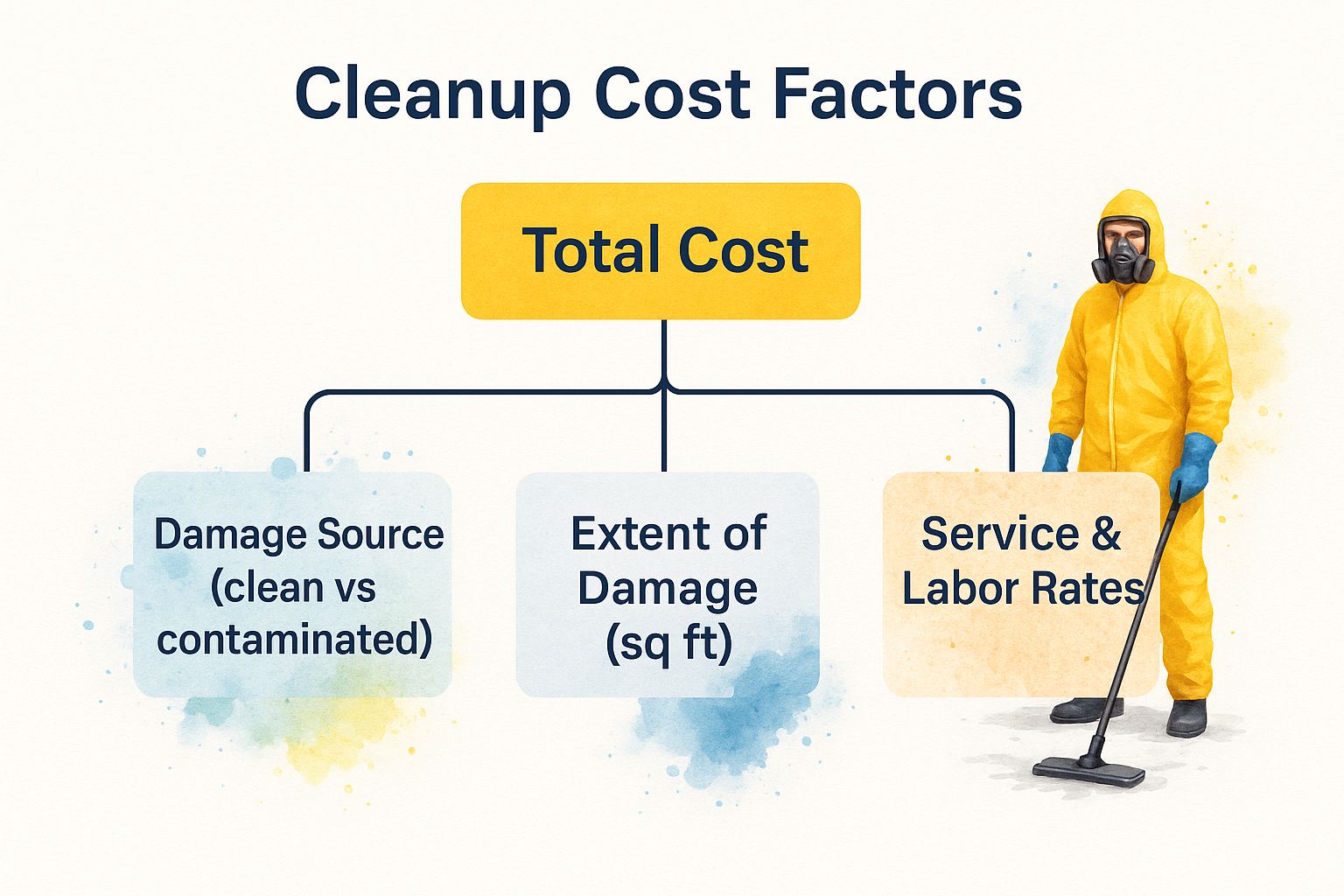
As you can see, the source of the water is a primary driver of the total bill, right alongside the total square footage and local labor rates.
This is the most dangerous and expensive category of them all. Black water is grossly contaminated and swarming with pathogens, toxins, and other harmful agents that can cause severe illness.
Any contact with black water requires extreme caution. Professionals must use specialized personal protective equipment (PPE) and follow aggressive, hazardous material cleanup protocols.
Common sources of Category 3 water include:
Cleaning up black water is an intensive, multi-step process. It almost always involves tearing out and safely disposing of all porous materials it touched—drywall, carpet, insulation, and even furniture. The entire area then has to be aggressively disinfected. Because of the severe health risks, homeowners should never try to clean up black water on their own. You can learn more about the complexities in our guide to professional sewer remediation services.
To put it all together, the water category dictates the entire scope of the job—from the equipment needed to the safety measures required. This is what ultimately determines your final water damage cleanup cost.
The difference in approach and cost between the three categories is significant. This table breaks down what you can expect for each level of contamination.
| Water Category | Description & Common Sources | Required Cleanup Actions | Average Cost Per Square Foot |
|---|---|---|---|
| Category 1 (Clean Water) | Water from sanitary sources like broken supply lines, overflowing sinks (no contaminants), or appliance malfunctions. | Water extraction, structural drying with air movers and dehumidifiers. | $3.75 – $4.25 |
| Category 2 (Grey Water) | Contaminated water from sources like dishwasher overflows, washing machine discharge, or toilet overflows (urine only). | Extraction, drying, plus carpet and surface cleaning with antimicrobial treatments. Some materials may need removal. | $4.50 – $5.50 |
| Category 3 (Black Water) | Grossly contaminated water from sewage backups, river flooding, or toilet overflows with feces. Poses serious health risks. | Full-scale remediation including removal of all porous materials (drywall, carpet, insulation), structural drying, and aggressive disinfection. Requires PPE. | $7.00 – $7.75 |
As you can see, a small Category 1 leak might just need some professional drying equipment. But a Category 3 event is a full-blown hazardous material cleanup operation, and the price reflects that complexity.
Beyond the type of water you’re dealing with, several other key variables will shape the final water damage cleanup cost. A professional restoration crew doesn’t just look at where the water came from; they assess how it has interacted with your home’s bones and finishes. Knowing what they’re looking for will help you have a much clearer conversation when you’re reviewing their estimate.
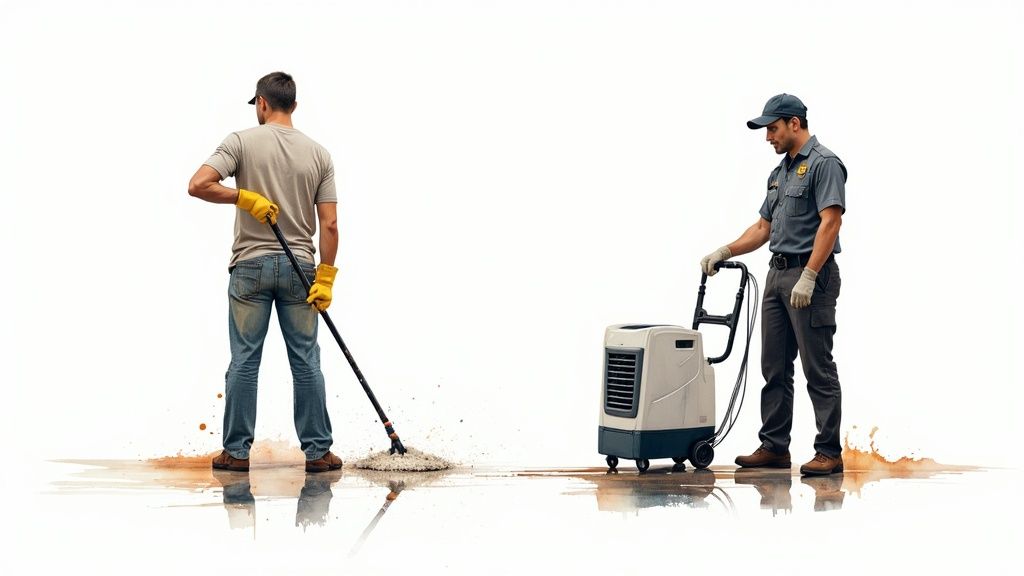
Think of it like a medical diagnosis. The water is the initial symptom, but the treatment plan—and its cost—depends entirely on how far the problem has spread and what parts of your home it has affected.
The most obvious factor is square footage. A small toilet overflow that’s contained on a tiled bathroom floor is a world away from a burst pipe that floods multiple carpeted rooms. The more ground the water covers, the more labor, equipment, and time will be needed for the cleanup.
Restoration pros often categorize damage into classes. Class 1 damage is minor and might only cost $150-$400, but severe Class 4 damage—where water has deeply saturated structural elements—can easily soar to $20,000-$100,000 or more.
When it comes to water damage, time is your worst enemy. The longer materials like drywall, wood, and insulation stay soaked, the more destructive and expensive the situation becomes.
Water damage isn’t a single event; it’s a process. Within hours, drywall starts to swell and lose its integrity. Within a couple of days, mold can take root, and the wood framing of your house begins to warp. What starts as a simple drying job can quickly escalate into a full-blown hazardous material cleanup.
This is exactly why a fast response is so important. A professional team arriving within hours can start the structural drying process right away, often saving materials that would otherwise need to be torn out and thrown away. Waiting even a day or two can dramatically inflate your final bill.
Different materials react to water in completely different ways, and that directly impacts the cost. An easy way to think about it is the difference between a sponge and a dinner plate. Drywall and insulation act like sponges, wicking moisture deep inside where you can’t see it. In contrast, tile or concrete acts more like a plate, keeping the water on the surface.
Here’s a quick breakdown of how common materials change the scope of the job:
Let’s look at two different situations to see how these factors come together to determine the water damage cleanup cost.
Scenario 1: The Contained Bathroom Leak in Pasadena
A water supply line to a toilet cracks, spilling clean (Category 1) water onto a small, tiled bathroom floor. The homeowner spots it, shuts off the main water valve within an hour, and calls for help.
Scenario 2: The Widespread Basement Flood in Glendale
During a heavy rainstorm, a sump pump fails. Groundwater (Category 3) backs up and fills the finished basement. The water sits for two full days before the homeowner discovers it.
Understanding why that second scenario is so intensive comes down to the science of drying a building. To learn more, check out our guide on structural drying for homeowners which explains the whole process.
Finding water damage in your home is bad enough without the added stress of a huge repair bill. Fortunately, your homeowners insurance policy can be a financial lifesaver—but only if you know how to navigate the claims process. Success comes down to one thing: knowing what your policy covers and, just as important, what it doesn’t.
Most standard policies cover damage that is sudden and accidental. That phrase is everything. A pipe that suddenly bursts and soaks your kitchen floor? That’s almost always covered. The same goes for a washing machine that overflows or a water heater that gives out without warning. These are the kinds of unexpected events insurance is designed for.
On the flip side, insurance carriers almost always deny claims for damage caused by gradual problems or poor maintenance. A slow drip under the sink that you didn’t notice for months, leading to rotted wood and mold, won’t be covered. Likewise, standard policies specifically exclude flooding from outside sources, like a river overflowing its banks. For that, you need a separate flood insurance policy from an entity like FEMA.
How you handle the first few hours makes all the difference for both limiting the damage and getting your insurance claim approved. Follow these steps carefully.
The insurance adjuster is the person who inspects the damage, checks your policy, and decides how much the insurance company will pay. A professional, cooperative attitude can go a long way here.
Be ready with all your documentation—photos, videos, and any receipts for things like tarps or shop vac rentals. The adjuster will want to visit your property to see the damage firsthand. Make sure you’re there for the inspection to point out everything you’ve found and answer their questions.
Key Insight: The insurance company’s first settlement offer is just that—an offer. If it feels too low or misses key repairs, don’t hesitate to push back. A detailed quote from your restoration company is your best tool for negotiating a fair payout.
It’s important to realize just how significant the water damage cleanup cost can be. Water damage is the second most common home insurance claim, accounting for 29.4% of all residential claims. The average insurance payout for these events falls between $11,605 and $13,954, which shows just how expensive proper restoration is.
This is a perfectly valid concern. Will filing one claim send your rates through the roof? Not necessarily. A single water damage claim might not lead to a big rate hike, but it could. Insurers set rates based on risk, and filing multiple claims in a short time can flag your property as a higher risk to insure.
That said, the financial protection a claim offers for a major water disaster almost always outweighs a potential premium increase. Professional restoration can easily climb into the tens of thousands—a bill most people can’t pay out of pocket. To get a better handle on the entire process, check out our guide on the typical insurance claim timeline.
When you’re dealing with a water emergency, panic can set in. The first instinct is often to Google “water damage help Los Angeles” and call the first name on the list. But taking just a few extra minutes to vet your choice can save you from a second, even worse, disaster.
The difference between a true professional and a cheap operator is staggering. A reputable team doesn’t just get your property dry; they provide the detailed documentation your insurance company needs to process your claim smoothly. A bad one? They might cut corners, leaving hidden moisture that turns into a massive mold or rot problem months down the road—long after they’ve cashed your check.
Choosing the right company is your best defense against future headaches and an inflated water damage cleanup cost.
First things first: IICRC certification is non-negotiable. The Institute of Inspection, Cleaning and Restoration Certification is the gold standard for our industry worldwide. Technicians who hold this certification have passed rigorous exams on the proper science-backed procedures for everything from water removal to structural drying and mold remediation.
Hiring an IICRC-certified firm means you’re bringing in a team that truly understands the science of restoration. They know how to use moisture meters to find hidden water, set up drying equipment for maximum efficiency, and follow strict safety protocols. If a company isn’t certified, walk away.
This is another critical checkpoint. Any contractor entering your home absolutely must carry two key types of insurance:
Ask to see proof of both before any work begins. A legitimate company will have their certificates ready and won’t hesitate to share them. If they give you the runaround, it’s a massive red flag. Hiring an uninsured contractor is a financial risk you can’t afford to take.
Expert Tip: A professional restoration company should be completely transparent. If you feel like you have to dig to find their license number, insurance status, or IICRC credentials, that’s a warning sign. Trustworthy businesses are proud of their qualifications and display them openly.
Once you’ve confirmed their credentials, it’s time to get a feel for their process and professionalism. A good company will have clear, confident answers to these questions.
Choosing the right partner is arguably the most important decision you’ll make after discovering water damage. For a more detailed guide, see our article on how to choose the best restoration company in Los Angeles.
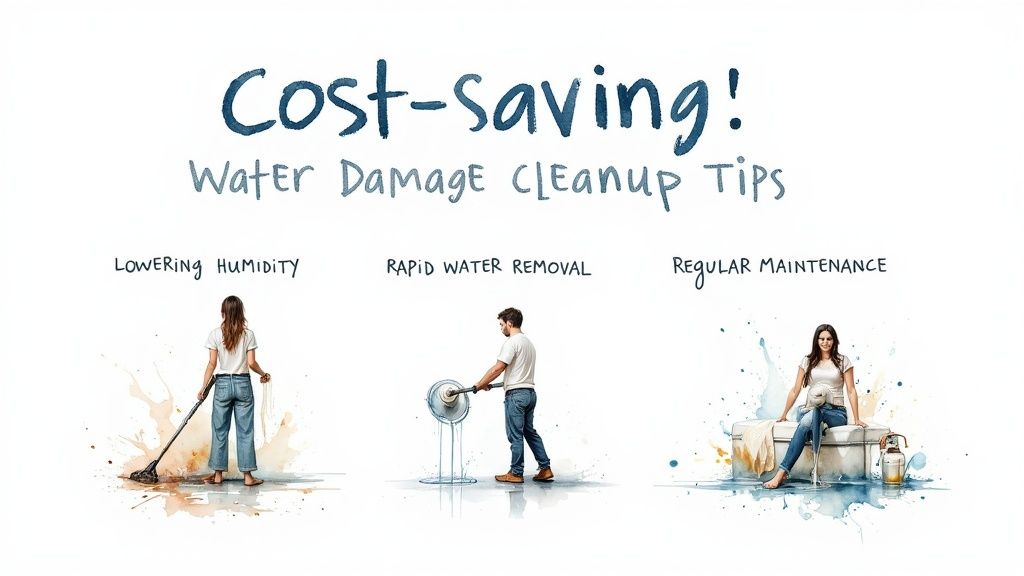
When you’re dealing with the chaos of water damage, financial questions are often the first to come up. We get it. Below are some straight answers to the most common questions we hear from Los Angeles homeowners, designed to give you a clear picture as you figure out your next steps.
For most homeowners, drying out a flooded basement will land somewhere between $2,000 and $10,000, although severe situations can push that number higher. That’s a huge range, and for good reason—several factors drive the final bill.
The size of your basement is the most obvious one. A larger space simply takes more labor and equipment. The depth of the water also matters, as does the type of water. A basement flooded with clean water from a supply line will be on the lower end of the cost spectrum. But one contaminated with sewage (Category 3 water) will cost far more due to the intensive cleaning and sanitizing required.
Finally, if materials like drywall, flooring, and insulation are too soaked to save, the cost will climb to include their removal and replacement.
It’s tempting to try and save a few bucks with a DIY approach, especially for what looks like a minor spill. For a tiny, clean water (Category 1) puddle on a hard surface like tile, you might be okay.
But for anything bigger, or any situation involving grey or black water, calling a professional is the only way to truly control the water damage cleanup cost in the long run.
The biggest danger with DIY is leaving hidden moisture behind. It gets trapped inside walls, under subfloors, and deep within insulation, creating the perfect breeding ground for mold. The future cost of professional mold remediation and fixing rotted structures will dwarf any initial savings you thought you made.
Key Takeaway: Professional restoration isn’t just about sucking up the water you can see. It’s about using specialized gear like moisture meters and thermal cameras to hunt down every last bit of hidden moisture, protecting both your home and your health.
Whether your insurance policy will pay for mold removal comes down to one thing: what caused the water damage in the first place? Most standard policies will cover mold remediation if it’s the result of a “covered peril,” like a pipe that suddenly and accidentally bursts.
However, there’s usually a catch. This coverage is often capped, frequently between $5,000 and $10,000. If the mold grew because of a slow leak you ignored, general lack of maintenance, or a flood (which requires separate flood insurance), your claim will almost certainly be denied. That’s why it’s so important to report a covered water loss to your insurer immediately.
The timeline can vary wildly. A small, contained leak might be wrapped up in a couple of days, while a major event affecting multiple rooms can easily take weeks to resolve.
Here’s a general idea of the phases:
A professional restoration company can give you a much more precise timeline after they’ve done a full on-site assessment.
Don’t let water damage sit. Every hour that passes allows the problem to get worse, driving up costs and risks. Onsite Pro Restoration offers 24/7 emergency services to get on site fast, start the drying process, and help you navigate the insurance claim. Call us now for a free, no-obligation assessment.

That sinking feeling when you spot mold is universal, especially in the humid pockets of Los Angeles. But before you grab the bleach, take a breath. The first step in
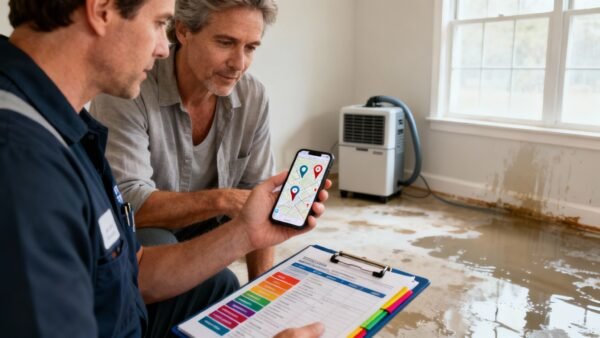
Finding a leak, flood, or any standing water in your home is always a shock. Those first few hours are absolutely critical—what you do right away can dramatically reduce the
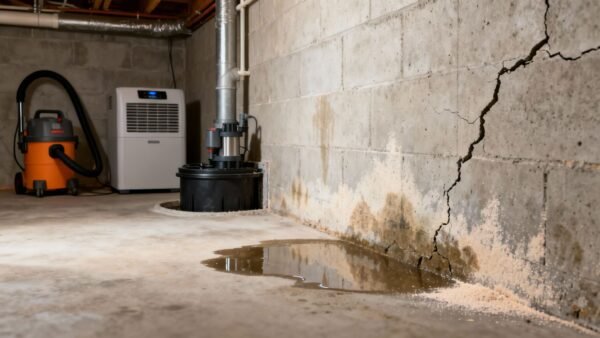
That small puddle in the corner of your basement isn't just a nuisance—it's an alarm bell for your home’s health. Any amount of basement water damage needs your immediate attention,

Pete Mantizian is the dedicated owner of Onsite Pro Restoration. He is driven by a passion to improve living conditions and prevent health issues caused by improper restoration. With over 10 years in construction and 7 years in restoration, Petros has managed projects for major franchises like Serv-Pro and 911 Restoration. He holds certifications in Applied Structural Drying, Microbial Remediation, and more. Committed to excellence, Petros ensures every project is done right the first time. Outside of work, he cherishes time with his loving wife and two children, balancing his fulfilling career with creating lasting family memories.
Share
For comprehensive damage restoration services, including biohazard mitigation, contact Onsite Pro Restoration at (818) 336-1800 or info@onsitepro.org. We’re available 24/7 to assist with all your emergency needs.